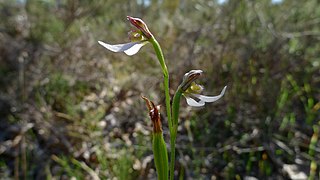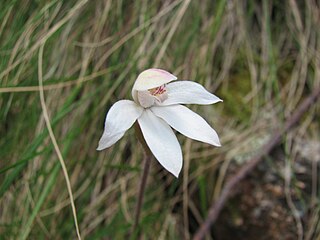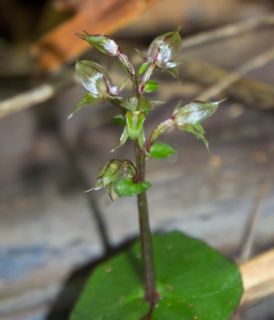
Caladenia, commonly known as spider orchids, is a genus of 350 species of plants in the orchid family, Orchidaceae. Spider orchids are terrestrial herbs with a single hairy leaf and a hairy stem. The labellum is fringed or toothed in most species and there are small projections called calli on the labellum. The flowers have adaptations to attract particular species of insects for pollination. The genus is divided into three groups on the basis of flower shape, broadly, spider orchids, zebra orchids and cowslip orchids, although other common names are often used. Although they occur in other countries, most are Australian and 136 species occur in Western Australia, making it the most species-rich orchid genus in that state.

Prasophyllum, commonly known as leek orchids, is a genus of about 140 species of flowering plants in the orchid family, Orchidaceae and is found in Australia and New Zealand. The Australian species are found in all states but have not been recorded in the Northern Territory. The common name arises from their having a hollow, leek- or onion-like leaf. Some species only flower after summer fires and have flowers similar to those of Xanthorrhoea which flower at the same time, suggesting that they employ the same pollinating insects. Leek orchids are similar to those in the genus Genoplesium except that the free part of the leaf is cylindrical and the labellum has a solid connection to the column. They range in size from the little laughing leek orchid at about 15 cm (6 in) to the king leek orchid which grows up to 2 m (80 in) tall.

Cyrtostylis, commonly known as gnat orchids, is a genus of five or six species of flowering plants in the orchid family Orchidaceae and is native to Australia and New Zealand. Cyrtostylis orchids often form dense colonies of genetically identical plants. They have a single heart-shaped leaf and a thin flowering stem with pale coloured insect-like flowers. The lateral sepals and petals are similar in size and colour but the labellum is shelf-like and conspicuous with two prominent glands at its base.

Eriochilus, commonly known as bunny orchids, is a genus of flowering plants in the orchid family, Orchidaceae that is endemic to Australia. Orchids in this genus are distinguished from those in the similar Caladenia by having a glabrous leaf and a densely woolly labellum. Species occur in south-west Western Australia, South Australia, Queensland, New South Wales, the Australian Capital Territory, Victoria, and Tasmania. Their common name alludes to their prominent ear-like lateral sepals.

Calochilus, commonly known as beard orchids, is a genus of about 30 species of plants in the orchid family, Orchidaceae. Beard orchids are terrestrial herbs with a single leaf at the base of the plant, or no leaves. Their most striking feature is a densely hairy labellum, giving rise to their common name. Beard orchids, unlike some other Australian orchids, do not reproduce using daughter tubers, but self-pollinate when cross-pollination has not occurred. Most species occur in Australia but some are found in New Zealand, New Guinea and New Caledonia.

Lyperanthus, commonly known as beak orchids, is a genus of flowering plants from the orchid family, Orchidaceae, that is endemic to Australia. There are two species, one in Western Australia and the other in four eastern Australian states, distinguished by their single long, narrow, leathery leaf and dull coloured flowers which have prominent short calli on their labellum. Both form loose colonies which reproduce asexually from their tubers, and sexually using their flowers.

Caleana, commonly known as duck orchids, is a genus of flowering plants in the orchid family, Orchidaceae that is found in Australia and New Zealand. The Australian species are found in all states but have not been recorded in the Northern Territory. Duck orchids have a single leaf and one or a few, dull-coloured, inconspicuous flowers. Most species are found in Western Australia but one species occurs in eastern Australia and one occurs in eastern Australia and New Zealand. Orchids in this genus as well as the hammer orchids (Drakaea) are pollinated by male thynnid wasps.

Calochilus paludosus, commonly known as the red beard orchid or red beardie, is a species of orchid native to Australia and New Zealand. It has a single fleshy, light green leaf and up to nine greenish flowers with reddish stripes. The labellum has a dull red or coppery coloured beard and lacks the "eye" spots of other beard orchids.

Caladenia alpina, commonly known as the mountain caladenia, is a plant in the orchid family Orchidaceae and is native to subalpine areas of south-eastern Australia and to New Zealand. It has a single fleshy leaf and a thin wiry flowering spike bearing two white flowers with red bars on the labellum. In New Zealand this orchid is sometimes known as Caladenia lyallii.

Caladenia gracilis, commonly known as musky caps or musky caladenia, is a plant in the orchid family Orchidaceae and is endemic to eastern and south-eastern Australia, including Tasmania. It is a ground orchid with a single leaf and up to six flowers which are dark-coloured on the back and white on the front, sometimes tinged with pink and with a strong musky or soapy odour. The species is also known as Caladenia moschata in Victoria.
Rhomboda, commonly known as velvet jewel orchids, is a genus of about twenty species of flowering plants in the orchid family Orchidaceae. Plants in this genus are mostly terrestrial herbs with a fleshy, creeping rhizome and a loose rosette of green to maroon coloured leaves. Small resupinate or partly resupinate, dull coloured flowers are borne on a hairy flowering stem. The dorsal sepal and petals overlap and form a hood over the column and there is a deep pouch at the base of the labellum. They are found in tropical regions from northern India through Southeast Asia, China, Japan to Australia and some Pacific Islands.

Acianthus sinclairii, commonly known as pixie cap or heart-leaf orchid, is a flowering plant in the orchid family Orchidaceae and is endemic to New Zealand. It is a terrestrial herb with a single, heart-shaped leaf and up to ten translucent green flowers, usually tinged maroon.

Caladenia congesta, commonly known as black-tongue caladenia, is a plant in the orchid family Orchidaceae and is endemic to Australia. It is a ground orchid with a single, sparsely hairy leaf, and up to three bright pink flowers with the central part of the labellum completely covered with black calli. It is a widespread species but not common in any part of its range.

Pterostylis foliata, commonly known as the slender greenhood, is a species of orchid widespread in south-eastern Australia and New Zealand. Flowering plants have a rosette of three to six, dark green, crinkled leaves crowded around the flowering stem and a single dark green and brown flower with a deep V-shaped sinus between the lateral sepals.

Genoplesium pumilum, commonly known as the green midge orchid in Australia, and the yellow gumland leek orchid in New Zealand is a small terrestrial orchid native to south-eastern Australia and New Zealand. It has a single thin leaf fused to the flowering stem and up to twenty five green to yellowish-green flowers which sometimes have red markings. Australian and New Zealand authorities use the name Corunastylis pumila.
Cyrtostylis oblonga, commonly known as the winter orchid or gnat orchid, is a species of orchid endemic to New Zealand. It has a single rounded leaf and a flowering stem with up to four pink or pinkish green flowers with a flat, oblong labellum.
Cyrtostylis rotundifolia, commonly known as the winter orchid or gnat orchid, is a species of orchid endemic to New Zealand. It has a single egg-shaped leaf and a flowering stem with up to four pink or pinkish green flowers with a flat, oblong labellum. It is very similar to Cyrtostylis oblonga and more investigation is required to determine if they are distinct from each other.

Thelymitra pulchella, commonly called the striped sun orchid, is a species of orchid in the family Orchidaceae that is endemic to New Zealand. It has a single erect, fleshy, channelled leaf and up to fourteen blue flowers with darker stripes on the petal and sometimes also on the sepals. The column and its lobes are variable in shape and colour.

Adenochilus nortonii, commonly known as the white gnome orchid, is a plant in the orchid family Orchidaceae and is endemic to a few isolated locations in New South Wales. It has a long, thin underground rhizome, a single leaf and a single white flower with reddish glandular hairs on the outside. Its labellum has red bars and a central band of yellow calli.

Adenochilus gracilis is a plant in the orchid family Orchidaceae and is endemic to New Zealand. It has a long, thin underground rhizome, a single leaf on the flowering stem and a single white flower with glandular hairs on the outside. Its labellum has red to maroon bars and a central band of yellow calli but is almost obscured by the dorsal sepal.

















